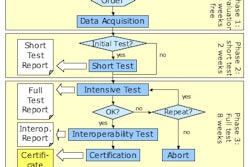The reductions to outpatient imaging reimbursement for Medicare beneficiaries, as mandated by the Deficit Reduction Act (DRA) of 2005, have been in place only a few short weeks -- too soon for its fiscal impact to be recognized by affected practices. However, the mitigation strategies that were crafted soon after the magnitude of the DRA cuts became clear may portend striking changes in the U.S. market for diagnostic imaging.
The DRA slashed the compensation for out-of-hospital imaging studies on Medicare beneficiaries by capping the technical component reimbursement for physician-office imaging to the lesser amount of either the Hospital Outpatient Prospective Payment System (HOPPS) or the Medicare Part B Physician Fee Schedule (MPFS). Diagnostic imaging is also coping this year with Centers for Medicare and Medicaid Services (CMS) reimbursement reductions for the technical portion of MR, CT, and ultrasound exams on contiguous body parts performed in the same session.
Despite legislative efforts in both the House of Representatives (H.R. 5704) and Senate (S. 3795) to delay reimbursement reductions, the DRA took effect at the beginning of the year -- the worst-case scenario for outpatient diagnostic imaging providers. According to studies commissioned or performed by outpatient imaging advocates, these practices could see annual revenues drop by a third or more.
The Washington, DC-based Access to Medical Imaging Coalition (AMIC), a lobbying group of physicians, patients, and providers formed to oppose the DRA, is working to craft new legislation to halt the DRA's outpatient imaging provisions, according to Timothy Trysla, AMIC's executive director.
"We're working closely with lawmakers in the new Congress, and hope to see bills introduced soon that will call for a delay in implementation of the DRA's cuts to outpatient imaging reimbursement," he said.
Meanwhile, savvy imaging center administrators and business managers have not been betting their businesses on hopes of a legislative fix. They applied the new rates to their procedure and payor mix, tallied up the totals, and calculated how big a fiscal hit they could expect this year. Contingency plans were crafted and mitigation strategies were developed in light of the new reimbursement realities. The moves they forecast, and are in the process of making in these areas, could ripple across the entire continuum of diagnostic imaging in the U.S.
Personnel
"All personnel options are on the table," said Darlene Zase. "This includes layoffs."
Zase is the executive director of one of the oldest independent radiology practices in the U.S., Trumbull, CT-based Advanced Radiology Consultants (ARC), which recently marked its 100th anniversary of providing radiological services to residents of southern Connecticut.
Although the group has not reduced its professional staff of technologists and radiologists, it has re-evaluated the efficacy of maintaining some business functions in-house. To this end, the practice has outsourced its billing services to an independent contractor, according to Zase.
Another center company, Liberty Medical Imaging, is also mulling personnel reductions. "We've put a freeze on new hires for some positions, and areas that are open for layoffs are now on the table," said Steven Renard, president and chief operating officer of LPMI.
The Encino, CA-based firm has four facilities in California and one in Columbus, OH, and also offers management services for imaging centers through its Liberty Pacific Medical Management subsidiary.
In contrast to other independent imaging center firms, Radiological Associates of Sacramento Medical Group (RAS) of Sacramento, CA, has no plans to downsize.
"We conducted our DRA assessment last year and believe our current staffing levels are consistent with that analysis," said Fred Gaschen, executive vice president of RAS.
The practice, which is the largest privately held imaging provider in the U.S., maintains 16 imaging centers, seven radiation oncology centers, six hospitals, 74 physicians, and more than 900 employees.
Equipment
In the past six years, the growth of outpatient imaging facilities in the U.S. has fueled the placement of various diagnostic imaging modalities, from ultrasound to linear accelerators. With the enactment of the DRA, imaging equipment manufacturers are unlikely to enjoy the robust sales numbers of the recent past in this market segment. In addition, some high-end imaging devices, such as 3-tesla MRI systems, may have a more difficult time clearing the hurdles of business managers' pro formas.
Although ARC has not declared a halt on the acquisition of new imaging technology, capital investment for new imaging equipment is on a slower track.
"What we're doing now is evaluating new modalities much more carefully," Zase said.
LPMI, which recently opened facilities with a variety of high-end CT and MRI systems in San Francisco and Castro Valley, CA, does not rule out adding new imaging devices if market conditions dictate their acquisition. For practical purposes, however, the firm sees itself in a moratorium period for capital expenditures in this area, according to Renard.
Gaschen said that RAS did not change its equipment acquisitions for 2006 in response to the DRA, and it scrutinizes any equipment purchases in light of the new reimbursement rules.
"We don't put in a new piece of equipment or a new service without doing a pretty exhaustive pro forma," he said.
Gaschen is developing new business opportunities in 3D ultrasound and digital radiography, and the practice plans on acquiring a new image-guided radiotherapy (IGRT) system in the near future. as well as replacing some of its older MRI systems with 1.5-tesla units.
"We looked at 3-tesla systems," he said. "But we don't believe that they are yet ready for prime time."
Information technology
One positive element of DRA may be its effect on the development and deployment of information systems for imaging practices. Radiology administrators and business managers say they're looking for IT to help them cut costs and deal with higher volumes.
In particular, they're on the lookout for low-maintenance RIS, PACS, and practice management products that can provide better workflow and demonstrably speed report and billing output. They are also actively evaluating in-house services tied to IT, such as billing, transcription, and data archiving, to see if these components would be more economical if outsourced to an independent firm.
LPMI has taken matters into its own hands when it comes to finding applications to meet the needs of its business. The firm is investing in and developing workflow analysis tools to aid in tuning its centers for maximum throughput.
According to Renard, the practice is evaluating RIS/PACS products with an eye on system maintenance, as well as on image compression strategies that can help reduce telephony-based data costs.
"Leasing T1 lines or fractional T3 lines is expensive," he said. "We're looking to get better compression, without degradation in image quality, so that we don't have to buy additional high-speed lines."
ARC is also reviewing its current RIS, PACS, and practice management applications to ensure that these systems are providing the most streamlined processes possible, Zase said.
Gaschen noted that RAS has its healthcare IT infrastructure in place but that it is examining ways in which it might better maximize the technology and systems.
Marketing and leasing
To mitigate the revenue cuts mandated by the DRA, many outpatient imaging facilities have stepped up their marketing efforts. LPMI's Renard said his group has expanded marketing its services to potential referrers, such as otolaryngologists, whom the practice had not expended much effort on in the past.
"It's about increasing the volume," he said.
Ramping up marketing efforts is something that every outpatient imaging practice should be addressing, according to W. Kenneth Davis Jr., a partner in the Chicago-based law firm of Katten Muchin Rosenman in Chicago.
"With the DRA 2005 reimbursement cuts having been implemented and most private payors following suit, marketing may be one of the few proactive things an imaging practice can do to stay in business," he wrote in an e-mail to AuntMinnie.com. "As margins are dramatically scaled back, imaging is becoming much more of a volume-driven business. In addition, hospital outpatient imaging is now at less of a competitive disadvantage. So marketing is more important now than it has ever been."
While focusing on marketing as a strategy to build the patient volumes needed to remain competitive and viable in an era of decreased reimbursement, outpatient imaging centers must be mindful of regulatory concerns, according to Davis.
"Unfortunately, unless conducted with a constant eye on the legal implications, marketing in the healthcare world can be fraught with risk," he wrote. "For this reason, imaging practices are cautioned to keep in mind some guiding principles when they plan their marketing tactics and marketing-related activities."
Davis offered the following marketing guidelines for outpatient imaging center marketing:
- Be wary of all cash or cash-equivalent payments to referral sources or their staff.
- Any whiff of a quid pro quo arrangement is a big problem.
- Anything that appears to be based upon the volume or value of referrals is also a problem.
- The legal risks grow almost exponentially with the size of any benefit you convey on referral sources (and particularly remember the $300 limit under the Stark law).
- Risks are lower, and how something looks on first blush are better, if you market to all referring physicians, not just heavy referrers.
- Be careful how you use and compensate independent sale representatives and third-party marketing firms.
- Education is good, but education with too much entertainment is bad.
- You can almost never get into trouble marketing based on clinical considerations, quality, and/or service.
- Use reasonable, fact-based statements and avoid hyperbole.
- Implement and live by a compliance plan.
Unless a practice is running its outpatient imaging center 24 hours a day, seven days a week, there are times when it's closed. And not every piece of imaging equipment is being utilized at every moment a center is open. Many facilities have considered operational-hours leasing or after-hours leasing of its equipment to another radiology practice or specialty; such deals may appear particularly attractive as groups struggle with new reimbursement cuts.
"Even before DRA 2005, leasing and infrastructure sharing deals have generally been a feasible way to make more efficient use of imaging resources," Davis wrote. "In the relatively recent past, some types of these deals have come under regulatory scrutiny. The deals really under the microscope have been so-called 'per-click' deals."
"For example, although the federal government has indicated that per-click lease payments can be legal if properly structured, it has also suggested that these arrangements can be suspect for creating a 'success fee,'" Davis noted.
State governments, however, have taken a dramatically different view of these deals, as has been recently reported on AuntMinnie.com.
"As another example, the Louisiana State Board of Medical Examiners determined in June 2005 that per-click deals were a per se violation of their state's antikickback law," Davis wrote. "And then on January 17 this year, the Illinois attorney general announced that she had joined a whistleblower lawsuit that had targeted per-click lease arrangements offered by several Illinois imaging centers named as defendants. The complaint alleges violations of Illinois' insurance fraud statute and consumer fraud and deceptive practices statute."
The bottom line for outpatient imaging center facilities considering leasing equipment or infrastructure is to approach such arrangements carefully. Any potential deal should be thoroughly examined by an attorney experienced in the structuring, growth, and ongoing operations of imaging center businesses and joint ventures including business model development, analysis of regulatory and reimbursement issues, various types of financings, and mergers and acquisitions.
"If leasing and infrastructure sharing deals are structured properly, and in particular are not intended to incentivize business generation among the parties, then they should be OK," according to Davis. "For example, straight block time, fixed fair market value fee leases should still be viable. What's less clear is the viability of per-click deals. The bottom line is that this lack of clarity, and the overall enforcement climate, probably makes these deals more risky than they were in the past."
Going forward
The year ahead, and the foreseeable future, looks to offer an extremely rocky road for outpatient imaging center practitioners. Although organizations such as the AMIC, the American College of Radiology (ACR), and the National Coalition for Quality Diagnostic Imaging Services (NCQDIS) have committed themselves to finding legislative relief from the DRA, imaging centers have no choice but to deal with the current reimbursement reality.
Ed Eichhorn, president of Medilink Consulting Group, a Dumont, NJ-based healthcare management consulting company focused on radiology services, offered practical advice for practices striving to adapt to the new rates.
"The first thing is to examine your costs," he said. "If you're running a multimodality center, you should examine your costs by each modality or by each product line. You should then look to enact cost reductions that will help save money in your operations."
Eichhorn said a variety of software applications are available that can help administrators look at ways for their employees to work more efficiently. These types of cost savings, he said, show up almost immediately. For longer term viability, imaging centers will need to refocus or build efforts on marketing and sales.
"Improvements in the sales and services you provide deliver a little bit longer term benefit in dealing with the impact of the DRA," Eichhorn said. "If you improve sales today, it will be some time before the orders for tests start coming in from practices and you're able to bill for those services and get paid for them. In the long-term you improve by competing better in the markets that you serve; in the short-term you deal with the cash-flow reductions by looking at how you might get more money out of your day-to-day operations."
Gaschen noted that although the DRA-mandated reimbursement cuts are severe, the number of patients requiring diagnostic imaging services continues to grow, year after year. Once an outpatient imaging center practice has committed to a DRA-mitigation strategy, it then needs to focus on the primary elements of its business.
"It's about capturing the volume and providing great service," he said.
By Jonathan S. Batchelor
AuntMinnie.com staff writer
February 1, 2007
Related Reading
Strategic plan, debt reduction: Proper responses to DRA, January 24, 2007
DRA 2005: The potential impact on the diagnostic imaging market, December 11, 2006
DRA threatens to throttle PET, October 13, 2006
Study finds 87% of DRA reimbursement below procedure cost, September 19, 2006
DRA 2005 in practice: Where the rubber meets the road, April 27, 2006
Copyright © 2007 AuntMinnie.com



















